
|
It brightened up to 6.2 mag in June (June 24, Marco Goiato). Now it is fading. It has already faded down to 8.4 mag (July 14, Thomas Lehmann). It is observable in excellent condition in the Southern Hemisphere. In the Northern Hemisphere, it locates low in the south.
Date(TT) R.A. (2000) Decl. Delta r Elong. m1 Best Time(A, h)
July 16 15 5.28 -39 10.4 1.090 1.816 119 7.8 20:56 ( 18, 13)
July 23 14 43.32 -35 45.4 1.302 1.884 108 8.3 20:49 ( 27, 13)
|
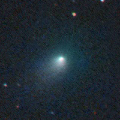
|
Now it is 11.5 mag (July 3, Marco Goiato). It keeps 11-12 mag until September. In the Northern Hemisphere, it will be getting lower gradually after this. In the Southern Hemisphere, it keeps observable in good condition for a long time.
Date(TT) R.A. (2000) Decl. Delta r Elong. m1 Best Time(A, h)
July 16 13 4.82 -4 8.7 1.306 1.552 82 11.4 20:56 ( 62, 27)
July 23 13 19.85 -6 44.2 1.343 1.546 80 11.4 20:49 ( 61, 24)
|

|
Now it is 13.4 mag (July 3, Ken-ichi Kadota). It will brighten up to 11 mag from summer to autumn. Now it is appearing in the morning sky, but it keeps low for some time.
Date(TT) R.A. (2000) Decl. Delta r Elong. m1 Best Time(A, h)
July 16 5 12.86 25 42.3 2.131 1.414 34 11.7 3:15 (246, 10)
July 23 5 38.90 25 8.2 2.095 1.394 35 11.6 3:22 (247, 12)
|

|
Now it is 11.3 mag (June 10, Hiroshi Abe). In the Northern Hemisphere, it will be unobservable soon. It locates somewhat low in the Southern Hemisphere, but it keeps observable until August.
Date(TT) R.A. (2000) Decl. Delta r Elong. m1 Best Time(A, h)
July 16 10 17.64 12 8.7 2.262 1.593 38 11.7 20:56 (102, 4)
July 23 10 37.23 10 22.5 2.287 1.592 36 11.8 20:49 (101, 2)
|

|
It brightened up to 8-9 mag from winter to spring. Now it is fading. It has already faded down to 11.9 mag (July 4, Thomas Lehmann). In the Northern Hemisphere, it will be getting lower gradually and will be unobservable in August. It is observable in the evening sky also in the Southern Hemisphere until August.
Date(TT) R.A. (2000) Decl. Delta r Elong. m1 Best Time(A, h)
July 16 11 28.25 19 37.4 3.754 3.240 52 12.1 20:56 ( 99, 22)
July 23 11 33.52 17 41.1 3.889 3.296 47 12.2 20:49 ( 99, 18)
|

|
It became so bright as 8 mag in 2009. Appearing in the morning sky. In the Northern Hemispehre, it will be observable at 11-12 mag from summer to autumn. In the Southern Hemisphere, it keeps extremely low for a long time until autumn.
Date(TT) R.A. (2000) Decl. Delta r Elong. m1 Best Time(A, h)
July 16 5 46.08 23 13.5 2.359 1.523 26 13.2 3:15 (243, 3)
July 23 6 10.40 23 1.8 2.318 1.498 27 12.7 3:22 (245, 5)
|

|
Now it is 12.5 mag (July 8, Juan Jose Gonzalez). It will be fading gradually after August. In the Northern Hemisphere, it keeps observable until early November. It becomes observable in the evening sky from July to September also in the Southern Hemisphere.
Date(TT) R.A. (2000) Decl. Delta r Elong. m1 Best Time(A, h)
July 16 15 10.68 47 33.1 2.836 2.982 88 12.9 20:56 (134, 70)
July 23 15 8.87 43 50.5 2.906 3.015 86 13.0 20:49 (121, 68)
|

|
It brightened up to 14 mag in minor outburst in early June. But it is faint as 15.6 mag now (July 13, Erik Bryssinck). It is observable in excellent condition in the Southern Hemisphere.
Date(TT) R.A. (2000) Decl. Delta r Elong. m1 Best Time(A, h)
July 16 19 34.41 -25 46.1 4.907 5.921 175 13.2 23:55 ( 0, 29)
July 23 19 30.85 -25 47.8 4.917 5.919 169 13.3 23:24 ( 0, 29)
|
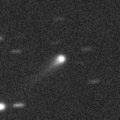
|
It brightened rapidly up to 13.1 mag (July 2, Juan Jose Gonzalez). It will be observable at 12-13 mag until autumn.
Date(TT) R.A. (2000) Decl. Delta r Elong. m1 Best Time(A, h)
July 16 13 33.19 -12 55.7 1.796 2.104 92 13.5 20:56 ( 50, 26)
July 23 13 43.30 -12 59.7 1.853 2.086 88 13.3 20:49 ( 52, 24)
|

|
It will brighten up to 13 mag in summer. But it keeps unobservable for a long time. It will appear in the morning sky in December, when the comet will be fainter than 15 mag.
Date(TT) R.A. (2000) Decl. Delta r Elong. m1 Best Time(A, h)
July 16 7 33.22 15 15.7 2.545 1.540 6 13.9 3:15 (232,-21)
July 23 7 56.37 14 6.8 2.507 1.503 6 13.8 3:22 (235,-20)
|
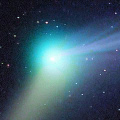
|
It brightened up to 6 mag from autumn to winter. Now it is fading. It has already faded down to 13.4 mag (May 22, Ken-ichi Kadota). In the Northern Hemisphere, it will be getting higher in the morning sky. It is not observable after this in the Southern Hemisphere.
Date(TT) R.A. (2000) Decl. Delta r Elong. m1 Best Time(A, h)
July 16 5 50.94 47 48.4 4.433 3.642 34 13.8 3:15 (223, 16)
July 23 5 54.94 48 10.6 4.453 3.720 39 13.9 3:22 (225, 21)
|
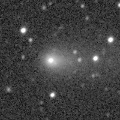
|
Now it is very bright as 12.9 mag (July 3, Juan Jose Gonzalez). It will be observable at 13 mag in good condition from spring to summer.
Date(TT) R.A. (2000) Decl. Delta r Elong. m1 Best Time(A, h)
July 16 21 12.82 -12 2.0 1.543 2.507 156 13.9 1:37 ( 0, 43)
July 23 21 9.96 -12 35.3 1.530 2.522 163 13.9 1:07 ( 0, 43)
|

|
Now it is 14.3 mag (July 3, Alan Hale). Distant object, but it keeps observable at 14-15 mag for a long time from 2015 to 2016.
Date(TT) R.A. (2000) Decl. Delta r Elong. m1 Best Time(A, h)
July 16 0 46.36 2 24.0 4.582 4.897 102 14.2 3:15 (314, 48)
July 23 0 48.64 2 15.0 4.487 4.901 108 14.2 3:22 (325, 52)
|

|
It is not observable now. It will be observable at 16.5 mag in September in the Northern Hemisphere, or in November in the Southern Hemisphere.
Date(TT) R.A. (2000) Decl. Delta r Elong. m1 Best Time(A, h)
July 16 7 19.88 18 6.7 3.001 1.994 6 14.4 3:15 (232,-17)
July 23 7 37.30 17 40.7 3.001 2.001 8 14.5 3:22 (236,-14)
|
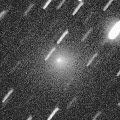
|
It brightened up to 10-11 mag in May. Now it is fading rapidly. It has already faded down to 15.6 mag (June 26, Yuji Ohshima). It is observable in excellent condition in the Northern Hemisphere. It is getting higher after this also in the Southern Hemisphere.
Date(TT) R.A. (2000) Decl. Delta r Elong. m1 Best Time(A, h)
July 16 15 42.04 30 53.3 1.389 1.887 102 14.6 20:56 ( 72, 78)
July 23 15 24.02 24 57.3 1.545 1.952 97 15.2 20:49 ( 69, 67)
|
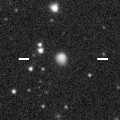
|
Now it is 14.3 mag (July 11, Artyom Novichonok). It is expected to brighten up to 7 mag in 2017 summer. In the Northern Hemisphere, it becomes low temporarily in summer, but it keeps observable in good condition until the highlight while the comet will be brightening. In the Southern Hemisphere, it is not observable until early 2017.
Date(TT) R.A. (2000) Decl. Delta r Elong. m1 Best Time(A, h)
July 16 8 47.83 53 57.0 5.029 4.236 34 14.8 20:56 (147, 14)
July 23 9 0.06 53 28.5 4.965 4.171 34 14.7 20:49 (147, 13)
|
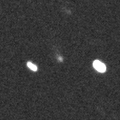
|
Now it is bright as 14.9 mag (May 4, Hidetaka Sato). It keeps 15 mag until autumn. In the Southern Hemisphere, it keeps observable for a long time. It will be unobservable after this in the Northern Hemisphere.
Date(TT) R.A. (2000) Decl. Delta r Elong. m1 Best Time(A, h)
July 16 7 35.75 -50 37.3 2.419 2.316 71 14.9 3:15 (309,-52)
July 23 8 5.31 -52 40.5 2.417 2.328 72 14.9 3:22 (313,-51)
|
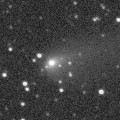
|
Now it is 13.9 mag (July 2, Chris Wyatt). It will be fading gradually after this. It is observable in excellent condition in the Southern Hemisphere. But it locates somewhat low in the Northern Hemisphere.
Date(TT) R.A. (2000) Decl. Delta r Elong. m1 Best Time(A, h)
July 16 15 22.49 -22 36.0 1.862 2.532 120 14.9 20:56 ( 19, 30)
July 23 15 26.40 -22 45.4 1.959 2.554 114 15.1 20:49 ( 23, 28)
|

|
Now it is 14.2 mag (July 2, Chris Wyatt). In the Northern Hemisphere, it will be unobservable soon. In the Southern Hemisphere, it keeps observable in good condition until autumn. But it will be fading slowly after this.
Date(TT) R.A. (2000) Decl. Delta r Elong. m1 Best Time(A, h)
July 16 12 59.54 -23 28.6 2.160 2.376 89 15.1 20:56 ( 49, 12)
July 23 13 7.85 -24 31.5 2.247 2.384 85 15.2 20:49 ( 50, 10)
|

|
Now it is 15.4 mag (July 3, Hidetaka Sato), brighter than originally predicted. Now it is brightest. In the Southern Hemisphere, it keeps observable until winter, but it locates somewhat low. In the Northern Hemisphere, it will be getting higher after this, and it will be observable in excellent condition.
Date(TT) R.A. (2000) Decl. Delta r Elong. m1 Best Time(A, h)
July 16 3 58.55 10 45.1 1.771 1.442 54 15.2 3:15 (269, 17)
July 23 4 17.53 12 56.9 1.754 1.454 55 15.3 3:22 (269, 21)
|
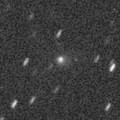
|
Now it is 15.5 mag (July 5, Hidetaka Sato). It will brighten up to 14 mag in summer. It is observable in excellent condition in the Northern Hemispehre. In the Southern Hemisphere, it keeps locating low until August, but it will be observable in good condition after September.
Date(TT) R.A. (2000) Decl. Delta r Elong. m1 Best Time(A, h)
July 16 1 26.96 43 16.1 1.898 1.961 78 15.8 3:15 (243, 59)
July 23 1 9.81 44 29.1 1.720 1.939 86 15.6 3:22 (237, 68)
|
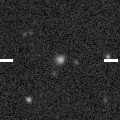
|
Now it is 16.6 mag (June 29, MASTER-SAAO Observatory). It will be unobservable temporarily from summer to autumn. Then it will appear in the morning sky at 13 mag in December. It is expected to brighten up to 7 mag in 2017 spring. But it locates somewhat low at the high light.
Date(TT) R.A. (2000) Decl. Delta r Elong. m1 Best Time(A, h)
July 16 11 22.68 -0 51.0 4.554 4.110 58 15.9 20:56 ( 82, 9)
July 23 11 27.25 -1 11.8 4.571 4.037 52 15.9 20:49 ( 84, 6)
|
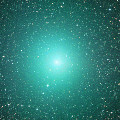
|
It passed only 0.036 a.u. from the earth on Mar. 21-22, and brightened up to 3.9 mag (Mar. 21, Thomas Lehmann). It kept brightening even after the perihelion passage. However, it is fading rapidly now. It has already faded down to 17.1 mag (June 29, Hidetaka Sato). It keeps observable in excellent condition for a while after this both in the Northern Hemisphere and Southern Hemisphere.
Date(TT) R.A. (2000) Decl. Delta r Elong. m1 Best Time(A, h)
July 16 16 39.83 -2 42.8 0.997 1.839 131 15.9 21:01 ( 0, 52)
July 23 16 43.73 -4 5.7 1.105 1.901 127 16.6 20:49 ( 5, 51)
|
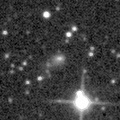
|
Now it is 16.8 mag (June 3, Yasukazu Ikari). It will be observable at 13 mag for a long time from 2017 to 2018. In 2016, it keeps observable at 16-17 mag in good condition until autumn.
Date(TT) R.A. (2000) Decl. Delta r Elong. m1 Best Time(A, h)
July 16 19 30.00 -10 36.5 5.167 6.167 168 16.3 23:50 ( 0, 44)
July 23 19 22.95 -10 24.3 5.137 6.124 165 16.2 23:16 ( 0, 45)
|
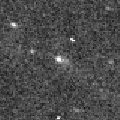
|
First return of a new periodic comet which brightened up to 16.5 mag in 2008. The condition of this apparition is very good. It is expected to brighten up to 15.5 mag in autumn and will be observable in good condition. Now it is 18.8 mag (July 3, E. Schwab, D. Abreu), fainter than predicted by 2 mag.
Date(TT) R.A. (2000) Decl. Delta r Elong. m1 Best Time(A, h)
July 16 0 26.80 -18 28.0 1.892 2.480 113 16.4 3:15 (333, 32)
July 23 0 29.25 -18 0.4 1.802 2.463 119 16.2 3:22 (341, 35)
|
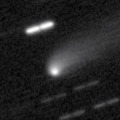
|
It brightened very rapidly in 2015 spring, and reached up to 13.8 mag (2015 May 11, Sandor Szabo). Now it is 15.7 mag (June 7, Yasukazu Ikari). In the Northern Hemisphere, it will be unobservable in August. In the Southern Hemisphere, it keeps observable until October, but it will be fading.
Date(TT) R.A. (2000) Decl. Delta r Elong. m1 Best Time(A, h)
July 16 13 49.02 -24 48.9 4.155 4.450 100 16.3 20:56 ( 39, 19)
July 23 13 52.63 -24 43.7 4.285 4.480 94 16.4 20:49 ( 43, 16)
|
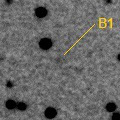
|
Now it is 16.2 mag (June 29, iTelescope Observatory, Siding Spring). It keeps 16 mag for a long time from 2016 to 2017. In 2016, it is observable in excellent condition in the Southern Hemisphere, but it locates extremely low in the Northern Hemispehre.
Date(TT) R.A. (2000) Decl. Delta r Elong. m1 Best Time(A, h)
July 16 12 37.03 -24 15.9 3.417 3.478 84 16.5 20:56 ( 52, 8)
July 23 12 44.64 -23 18.4 3.486 3.453 79 16.5 20:49 ( 55, 7)
|
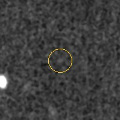
|
New comet discovered from the STEREO spacecraft images in May. It brightened up to 8 mag due to the forward scattering. It must be observable high in the evening sky in the Southern Hemisphere. It it not observable in the Northern Hemisphere.
Date(TT) R.A. (2000) Decl. Delta r Elong. m1 Best Time(A, h)
July 16 11 9.39 -10 31.8 1.343 1.214 60 16.5 20:56 ( 76, 1)
July 23 11 41.61 -12 41.2 1.458 1.320 61 17.0 20:49 ( 73, 2)
|
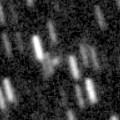
|
Now it is 17.8 mag (June 30, A. Maury, J.-B. de Vanssay, J.-F. Soulier, J.-G. Bosch, T. Noel). It keeps 16.5 mag for a long time in 2016, and it will be observable in excellent condition in the Southern Hemisphere. It is hardly observable in the Northern Hemisphere.
Date(TT) R.A. (2000) Decl. Delta r Elong. m1 Best Time(A, h)
July 16 3 42.36 -39 37.9 3.411 3.433 82 16.5 3:15 (312,-10)
July 23 3 39.54 -40 43.0 3.341 3.447 87 16.5 3:22 (317, -6)
|
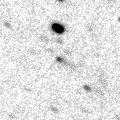
|
It is expected to brighten up to 16 mag and observable in good condition in autumn. However, it is so faint as 18.6 mag now (June 30, A. Maury, J.-B. de Vanssay, J.-F. Soulier, J.-G. Bosch, T. Noel).
Date(TT) R.A. (2000) Decl. Delta r Elong. m1 Best Time(A, h)
July 16 23 19.57 -11 44.6 2.217 2.946 127 16.7 3:15 (350, 43)
July 23 23 19.59 -11 37.7 2.128 2.924 133 16.6 3:16 ( 0, 43)
|

|
Now it is 16.2 mag (July 5, Hidetaka Sato). It will be observable at 16 mag in good condition from autumn to winter. It locates somewhat low in the Southern Hemisphere.
Date(TT) R.A. (2000) Decl. Delta r Elong. m1 Best Time(A, h)
July 16 3 6.37 22 42.2 2.795 2.509 63 16.7 3:15 (264, 34)
July 23 3 17.82 23 46.7 2.722 2.509 67 16.7 3:22 (266, 39)
|

|
Now it is 16.5 mag (June 16, J. Camarasa). It keeps 16.5 mag from 2016 to 2017. It is observable in good condition in the Northern Hemisphere. In the Southern Hemisphere, it locates low in 2016, and it is not observable in 2017.
Date(TT) R.A. (2000) Decl. Delta r Elong. m1 Best Time(A, h)
July 16 16 40.10 35 39.5 5.929 6.326 108 16.7 21:01 (180, 89)
July 23 16 37.22 35 38.5 5.981 6.319 104 16.7 20:49 (100, 86)
|
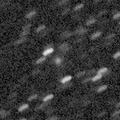
|
Now it is 17.1 mag (June 14, Mt. Lemmon Survey). It will brighten up to 16.5 mag in summer and will be observable in good condition.
Date(TT) R.A. (2000) Decl. Delta r Elong. m1 Best Time(A, h)
July 16 17 41.49 -11 3.1 1.825 2.748 149 16.8 22:02 ( 0, 44)
July 23 17 37.93 -10 57.1 1.852 2.728 142 16.7 21:31 ( 0, 44)
|
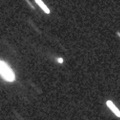
|
Now it is 17.0 mag (June 16, Catalina Sky Survey). It brightened rapidly, and became brighter than originally expected. It keeps 17 mag until 2017. In the Northern Hemisphere, it keeps observable in excellent condition for a long time, although it becomes low temporarily in autumn. It is not observable in the Southern Hemisphere.
Date(TT) R.A. (2000) Decl. Delta r Elong. m1 Best Time(A, h)
July 16 13 4.61 66 49.5 7.618 7.277 66 16.9 20:56 (153, 46)
July 23 13 2.58 65 39.1 7.650 7.276 64 16.9 20:49 (150, 44)
|
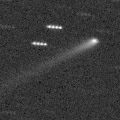
|
It brightened up to 15 mag from late 2014 to early 2016. Now it is fading slowly. Now it is 16.6 mag (June 16, Catalina Sky Survey). In the Northern Hemisphere, it will be observable at 17 mag in autumn in good condition. It locates extremely low in the Southern Hemisphere.
Date(TT) R.A. (2000) Decl. Delta r Elong. m1 Best Time(A, h)
July 16 23 59.50 40 41.0 4.750 4.925 93 16.9 3:15 (242, 75)
July 23 23 51.88 41 41.6 4.681 4.955 99 16.9 3:22 (216, 81)
|
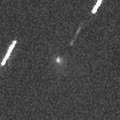
|
Now it is 17.5 mag (June 17, Catalina Sky Survey). It keeps 17-18 mag until autumn. It keeps observable in excellent condition in the Northern Hemisphere. It will be getting lower gradually in the Southern Hemisphere.
Date(TT) R.A. (2000) Decl. Delta r Elong. m1 Best Time(A, h)
July 16 22 29.22 21 11.6 1.595 2.292 121 17.1 2:54 ( 0, 76)
July 23 22 9.33 25 20.2 1.543 2.294 126 17.0 2:07 ( 0, 80)
|

|
It brightened up to 3.7 mag and became a naked eye comet in mid January in 2015 (Jan. 13, Marek Biely). Now it is fading. It has already faded down to 15.6 mag (June 13, Catalina Sky Survey). In the Northern Hemisphere, it keeps observable for a long time until the comet fades out. It locates somewhat low in the Southern Hemisphere.
Date(TT) R.A. (2000) Decl. Delta r Elong. m1 Best Time(A, h)
July 16 17 28.31 23 52.9 5.558 6.187 124 17.1 21:49 ( 0, 79)
July 23 17 24.56 23 2.9 5.665 6.248 120 17.2 21:18 ( 0, 78)
|
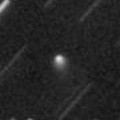
|
Now it is 16.7 mag (June 12, Mt. Lemmon Survey). It keeps brightening even after the perihelion passage. It keeps observable at 17 mag in good condition until autumn.
Date(TT) R.A. (2000) Decl. Delta r Elong. m1 Best Time(A, h)
July 16 14 32.38 8 26.6 6.429 6.655 98 17.2 20:56 ( 54, 51)
July 23 14 32.05 8 37.8 6.562 6.677 92 17.2 20:49 ( 60, 48)
|

|
Now it is 17.1 mag (July 3, Hidetaka Sato). It had been lost for a long time over 200 years since its discovery in 1783. The condition of this apparition is excellent, and it will brighten up to 15 mag in autumn. In the Northern Hemisphere, it will be getting higher rapidly after this, and will be observable in excellent condition from summer to winter. In the Southern Hemisphere, it keeps observable in good condition until November.
Date(TT) R.A. (2000) Decl. Delta r Elong. m1 Best Time(A, h)
July 16 3 46.02 -7 1.4 2.033 1.839 64 17.3 3:15 (285, 9)
July 23 3 58.26 -5 10.7 1.967 1.824 66 17.2 3:22 (287, 15)
|
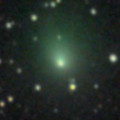
|
It brightened up to 10 mag in 2015 autumn. Now it is appearing in the morning sky. However, it has already faded down to 16.8 mag (June 13, iTelescope Observatory, Siding Spring).
Date(TT) R.A. (2000) Decl. Delta r Elong. m1 Best Time(A, h)
July 16 3 7.52 13 3.6 3.074 2.812 65 17.2 3:15 (274, 29)
July 23 3 14.55 13 23.7 3.025 2.853 70 17.3 3:22 (278, 34)
|

|
Now it is 18.4 mag (June 30, C. Jacques, E. Pimentel, J. Barros). It will brighten up to 16 mag and will be observable in good condition in 2017. In 2016, it is observable in excellent condition in the Southern Hemisphere, but it keeps low in the Northern Hemisphere.
Date(TT) R.A. (2000) Decl. Delta r Elong. m1 Best Time(A, h)
July 16 18 58.73 -40 25.0 2.376 3.344 158 17.3 23:19 ( 0, 15)
July 23 18 52.80 -40 15.0 2.383 3.325 153 17.2 22:46 ( 0, 15)
|

|
It brightened up to 13-14 mag from 2014 to 2015. Now it is fading. It has already faded down to 16.6 mag (June 5, Space Surveillance Telescope, Atom Site). It will be observable at 17 mag in 2016.
Date(TT) R.A. (2000) Decl. Delta r Elong. m1 Best Time(A, h)
July 16 23 26.81 -2 56.8 4.764 5.378 122 17.3 3:15 (346, 51)
July 23 23 26.14 -3 9.6 4.720 5.422 129 17.3 3:22 ( 0, 52)
|
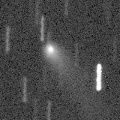
|
It was observed at 14-15 mag from 2014 to 2015. Now it is fading. In the Northern Hemisphere, it keeps observable in excellent condition until winter when the comet will be fainter than 18 mag. It is not observable in the Southern Hemisphere.
Date(TT) R.A. (2000) Decl. Delta r Elong. m1 Best Time(A, h)
July 16 3 47.10 67 9.4 6.125 5.660 58 17.5 3:15 (208, 38)
July 23 3 56.46 68 22.5 6.111 5.700 61 17.5 3:22 (207, 40)
|
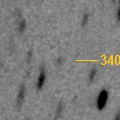
|
First return of a new periodic comet discovered in 2008. It keeps observable at 17.5 mag until autumn. Now it is 19.3 mag (July 5, A. C. Gilmore, P. M. Kilmartin), fainter than predicted.
Date(TT) R.A. (2000) Decl. Delta r Elong. m1 Best Time(A, h)
July 16 20 31.62 -18 20.2 2.129 3.131 167 17.6 0:57 ( 0, 37)
July 23 20 27.03 -18 31.7 2.110 3.124 175 17.5 0:24 ( 0, 37)
|

|
It was observed as bright as 13-14 mag for a long time from 2011 to 2014. Now it is fading. It is observable in excellent condition in the Southern Hemisphere. It locates extremely low in the Northern Hemisphere. No observations have been reported since August, 2015.
Date(TT) R.A. (2000) Decl. Delta r Elong. m1 Best Time(A, h)
July 16 17 13.51 -37 32.0 8.889 9.730 144 17.6 21:35 ( 0, 17)
July 23 17 9.67 -37 33.9 8.994 9.765 137 17.6 21:03 ( 0, 17)
|
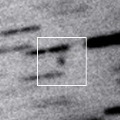
|
Now it is 17.7 mag (June 12, B. Lutkenhoner). It keeps observable at 17.5 mag in good condition from spring to autumn in the Southern Hemisphere. It is not observable in the Northern Hemisphere.
Date(TT) R.A. (2000) Decl. Delta r Elong. m1 Best Time(A, h)
July 16 17 38.90 -63 21.3 4.237 4.988 133 17.6 22:01 ( 0, -8)
July 23 17 35.97 -62 46.7 4.271 4.983 129 17.6 21:30 ( 0, -8)
|
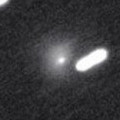
|
Very far object. Outburst occured on Feb. 20, 2015, and it brightened up to 15 mag. Now it is 17.8 mag (June 4, Space Surveillance Telescope, Atom Site). It is observable in excellent condition in the Southern Hemisphere. It locates low in the Northern Hemisphere.
Date(TT) R.A. (2000) Decl. Delta r Elong. m1 Best Time(A, h)
July 16 13 13.94 -21 49.6 9.123 9.209 91 17.9 20:56 ( 48, 16)
July 23 13 15.57 -21 43.2 9.236 9.212 85 18.0 20:49 ( 51, 13)
|

|
Now it is 17.6 mag (May 29, K. Hills). It was expected to brighten up to 14 mag from winter to summer. But it is much fainter actually. It will be observable in excellent condition in the Southern Hemisphere. It locates low in the Northern Hemisphere.
Date(TT) R.A. (2000) Decl. Delta r Elong. m1 Best Time(A, h)
July 16 16 6.26 -39 8.1 2.249 3.014 130 18.9 20:56 ( 6, 16)
July 23 16 8.67 -38 51.7 2.364 3.064 125 19.0 20:49 ( 9, 15)
|
|
![]()
 81P/Wild 2
81P/Wild 2 C/2014 S2 ( PanSTARRS )
C/2014 S2 ( PanSTARRS ) 144P/Kushida
144P/Kushida C/2014 W2 ( PanSTARRS )
C/2014 W2 ( PanSTARRS ) 29P/Schwassmann-Wachmann 1
29P/Schwassmann-Wachmann 1 237P/LINEAR
237P/LINEAR C/2015 TQ209 ( LINEAR )
C/2015 TQ209 ( LINEAR ) C/2013 US10 ( Catalina )
C/2013 US10 ( Catalina ) 53P/Van Biesbroeck
53P/Van Biesbroeck C/2011 KP36 ( Spacewatch )
C/2011 KP36 ( Spacewatch ) 118P/Shoemaker-Levy 4
118P/Shoemaker-Levy 4 C/2015 WZ ( PanSTARRS )
C/2015 WZ ( PanSTARRS ) C/2015 V2 ( Johnson )
C/2015 V2 ( Johnson ) C/2015 T4 ( PanSTARRS )
C/2015 T4 ( PanSTARRS ) 116P/Wild 4
116P/Wild 4 77P/Longmore
77P/Longmore 146P/Shoemaker-LINEAR
146P/Shoemaker-LINEAR C/2016 A8 ( LINEAR )
C/2016 A8 ( LINEAR ) C/2015 ER61 ( PanSTARRS )
C/2015 ER61 ( PanSTARRS ) 252P/LINEAR
252P/LINEAR C/2015 O1 ( PanSTARRS )
C/2015 O1 ( PanSTARRS ) 339P/2016 N1 ( McNaught )
339P/2016 N1 ( McNaught ) C/2014 W11 ( PanSTARRS )
C/2014 W11 ( PanSTARRS ) C/2016 B1 ( NEOWISE )
C/2016 B1 ( NEOWISE ) P/2016 J3 ( STEREO )
P/2016 J3 ( STEREO ) C/2015 B2 ( PanSTARRS )
C/2015 B2 ( PanSTARRS ) 188P/LINEAR-Mueller
188P/LINEAR-Mueller 56P/Slaughter-Burnham
56P/Slaughter-Burnham C/2014 OE4 ( PanSTARRS )
C/2014 OE4 ( PanSTARRS ) 219P/LINEAR
219P/LINEAR C/2014 R3 ( PanSTARRS )
C/2014 R3 ( PanSTARRS ) C/2014 A4 ( SONEAR )
C/2014 A4 ( SONEAR ) C/2016 K1 ( LINEAR )
C/2016 K1 ( LINEAR ) C/2014 Q2 ( Lovejoy )
C/2014 Q2 ( Lovejoy ) C/2015 LC2 ( PanSTARRS )
C/2015 LC2 ( PanSTARRS ) 226P/Pigott-LINEAR-Kowalski
226P/Pigott-LINEAR-Kowalski 22P/Kopff
22P/Kopff 47P/Ashbrook-Jackson
47P/Ashbrook-Jackson C/2012 F3 ( PanSTARRS )
C/2012 F3 ( PanSTARRS ) C/2014 N3 ( NEOWISE )
C/2014 N3 ( NEOWISE ) 340P/2016 N2 ( Boattini )
340P/2016 N2 ( Boattini ) C/2010 S1 ( LINEAR )
C/2010 S1 ( LINEAR ) C/2015 H2 ( PanSTARRS )
C/2015 H2 ( PanSTARRS ) C/2013 C2 ( Tenagra )
C/2013 C2 ( Tenagra ) C/2014 Y1 ( PanSTARRS )
C/2014 Y1 ( PanSTARRS )![]()










































